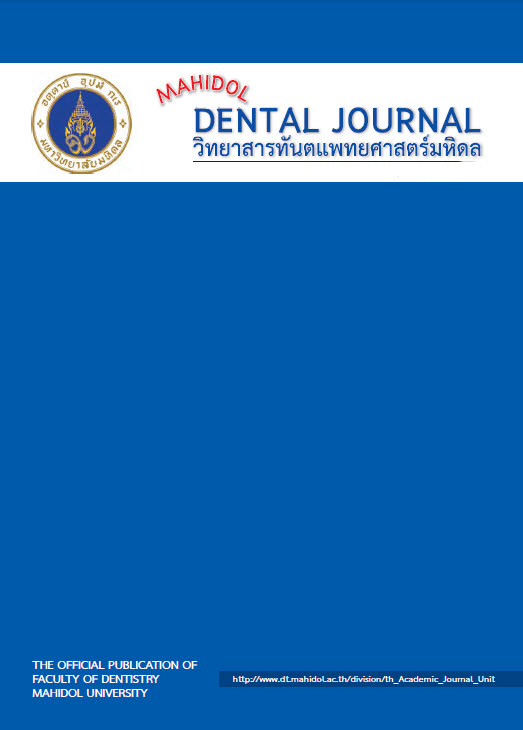The Effects of surface coating agents on surface microhardness of bis-acryl provisional materials
Main Article Content
Abstract
Objective: To compare surface microhardness of bis-acryl provisional materials after applied various types of surface coating agents by using Vickers hardness tester.
Materials and Methods: Forty bis-acryl specimens which were finished and polished were randomly divided into 8 groups, with n=5. 1) ProtempTM4 without surface coating, 2) ProtempTM4 coated with Palaseal®, 3) ProtempTM4 coated with EQUIA Forte® coat, 4) ProtempTM4 coated with OptibondTM FL, 5) LuxaTemp® without surface coating, 6) LuxaTemp® coated with Palaseal®, 7) LuxaTemp® coated with EQUIA Forte® coat, 8) LuxaTemp® coated with OptibondTM FL. The specimens from each group were tested for surface hardness by Vickers surface hardness tester. Load used was 50 gf. for 15 seconds. The indentations made were evaluated and measured with stereomicroscope at 50x. The measurements were converted into HV (Vickers hardness number) and analyzed with two-way ANOVA.
Results: The mean surface hardness values of LuxaTemp® group were statistically higher than ProtempTM4 group. The mean surface hardness values of LuxaTemp® group were statistically decreased after application of Palaseal® and OptibondTM FL. There were no statistically significant difference between the surface hardness values of LuxaTemp® coated with EQUIA Forte® coat and LuxaTemp® control group. However, it was statistically different from the surface hardness of the other groups.
Conclusion: From the limitation of this study, the three coating agents applied on ProtempTM4 have no effects on its surface microhardness. On the other hand, surface microhardness of coated LuxaTemp® group showed statistically significant decrease, except for EQUIA Forte® coating group which remains unchanged.
Keywords: Surface coating agent, Bis-acryl provisional materials, Microhardness
Article Details
References
Diaz-Arnold AM, Dunne JT, Jones AH. Microhardness of provisional fixed prosthodontic materials. J Prosthet Dent 1999; 82: 525-8.
Haselton DR, Diaz-Arnold AM, Vargas MA. Flexural strength of provisional crown and fixed partial denture resins. J Prosthet Dent 2002; 87: 225-8.
Takamizawa T, Barkmeier WW, Tsujimoto A, Scheidel D, Erickson RL, Latta MA, et al. Mechanical Properties and Simulated Wear of Provisional Resin Materials. Oper Dent. 2015; 40: 603-13.
Singh A, Garg S. Comparative Evaluation of Flexural Strength of Provisional Crown and Bridge Materials-An Invitro Study. J Clin Diagn Res 2016; 10: ZC72-7.
Ireland MF DD, Breeding LC, Ramp MH. In vitro mechanical property
comparison of four resins used for fabrication of provisional fixed
restorations. J Prosthet Dent 1998; 80: 158-62.
Mickeviciute E, Ivanauskiene E, Noreikiene V. In vitro color and roughness stability of different temporary restorative materials. Stomatologija 2016; 18: 66-72.
Cakan U, Kara HB. Effect of liquid polishing materials on the stainability of bis-acryl interim restorative material in vitro. J Prosthet Dent 2015; 113: 475-9.
Dede DO, Sahin O, Koroglu A, Yilmaz B. Effect of sealant agents on the color stability and surface roughness of nanohybrid composite resins. J Prosthet Dent 2016; 116: 119-28.
Nejatidanesh F, Momeni G, Savabi O. Flexural strength of interim resin materials for fixed prosthodontics. J Prosthodont 2009; 18: 507-11.
Milia E, Cumbo E, Cardoso RJ, Gallina G. Current dental adhesives systems. A narrative review. Curr Pharm Des 2012; 18: 5542-52.
Yap AU, Mah MK, Lye CP, Loh PL. Influence of dietary simulating solvents on the hardness of provisional restorative materials. Dent Mater 2004; 20: 370-6.
Thompson GA, Luo Q. Contribution of postpolymerization conditioning and storage environments to the mechanical properties of three interim restorative materials. J Prosthet Dent 2014; 112: 638-48.
Marie-France Bertrand EL, Miche` le Muller, Laurence Lupi–Pe´ gurier, Marc Bolla. Effect of Surface Penetrating Sealant on Surface Texture and
Microhardness of Composite Resins. J Biomed Mater Res 2000; 53: 658-63.
6507-1:2005 I. Metallic materials — Vickers hardness
test —Part 1:Test method International Organization for Standardization. 2005.
Shimada Y FS, Kumagai T. Evaluation of wear resistance of coating materials on GI restorative. Dent Mater 2015; 31: 24-5.


